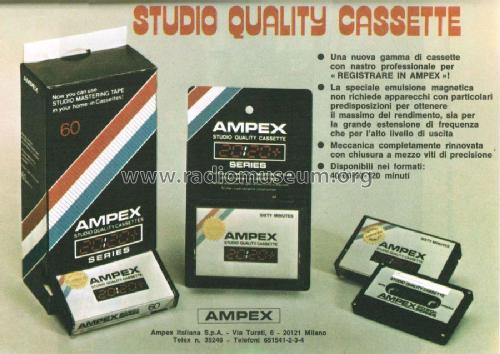Audiocassette - Compact Cassette - Musicassette All
Ampex; San Carlos, CA
- País
- Estados Unidos
- Fabricante / Marca
- Ampex; San Carlos, CA
- Año
- 1963 ?
- Categoría
- Miscelanea, objetos de propaganda, pines, banderines, ceniceros, otros, etc.
- Radiomuseum.org ID
- 329386
- Gama de ondas
- - no hay
- Especialidades
- Special Tape or Cassette-Format
- Tensión de funcionamiento
- No necesita alimentación
- Altavoz
- - - No hay salida de sonido.
- Material
- Plástico moderno (Nunca bakelita o catalina)
- de Radiomuseum.org
- Modelo: Audiocassette - Compact Cassette - Musicassette [All] - Ampex; San Carlos, CA
- Forma
- Formas varias descritas en notas aparte.
- Ancho, altura, profundidad
- 101.6 x 63.5 x 12.7 mm / 4 x 2.5 x 0.5 inch
- Anotaciones
-
This page is for all AMPEX Audio Cassette tapes.
Please do not modify this page.
Load only pictures with all data in the picture legend!A little history from Wikipedia.
The Audiocassette (Compact Cassette, CC), also called Musicassette (MusiCassette, MC) is an audio medium for electromagnetic analog recording and reproduction of sound signals.Designed in the early 1960s by a team of developers led by the inventor Lou Ottens of Dutch Philips.
The start of marketing was in 1963 and immediately the record companies added the same album recorded on audio cassette to the vinyl record. Widely used for ease of listening with portable recorders and car radios equipped with cassette players, it lasted until late 90s when it was supplanted by the advent of Compact Disc.
Consists of a standard size plastic container that holds magnetic tape of various lengths and declared height 1/8 inch, 3.17 cm, but really 0.15 inch, 3.81 cm. The commercially available tape lengths allow for recordings/playbacks from 15 to 60 minutes per side, at a standard speed of 4.76 cm/sec. In recent times, tapes with a duration of 150 minutes have also been produced, with characteristics close to CD quality. 180-minute tapes were also put on the market, almost immediately withdrawn from the market due to numerous problems. 240-minute tapes remained at project level and never released.
Four unified types of material from which the tape was made:
Type I, IEC I - iron oxide (Fe2O3); "Normal"
Type II, IEC II - chromium dioxide (CrO2); "Chrome"
Type III, IEC III - ferrochrome (FeCr); "Ferrochrome"
Type IV, IEC IV - pure iron (Fe). "Metal"
- Autor
- Modelo creado por Pier Antonio Aluffi. Ver en "Modificar Ficha" los participantes posteriores.
- Otros modelos
-
Donde encontrará 84 modelos, 81 con imágenes y 20 con esquemas.
Ir al listado general de Ampex; San Carlos, CA
